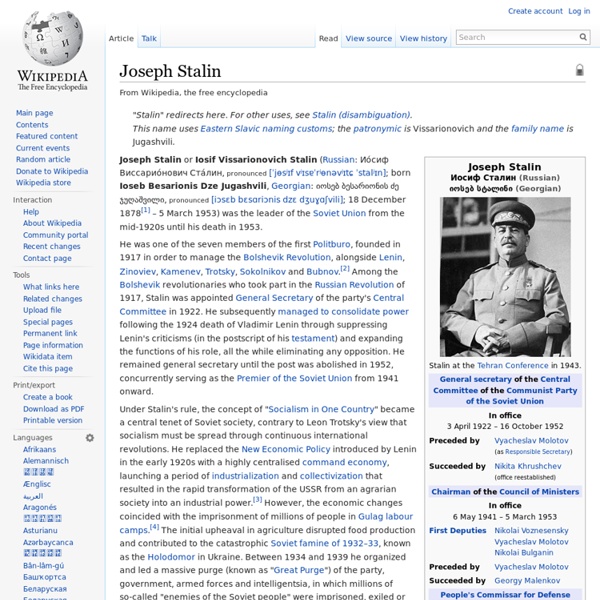Joseph Stalin - Biography - Dictator
Joseph Stalin ruled the Soviet Union for more than two decades, instituting a reign of terror while modernizing Russia and helping to defeat Nazism. Synopsis Born on December 18, 1879, in Gori, Georgia, Joseph Stalin rose to power as General Secretary of the Communist Party, becoming a Soviet dictator upon Vladimir Lenin's death. Stalin forced rapid industrialization and the collectivization of agricultural land, resulting in millions dying from famine while others were sent to camps. His Red Army helped defeat Nazi Germany during WWII. Early Life On December 18, 1879, in the Russian peasant village of Gori, Georgia, Iosif Vissarionovich Dzhugashvili (later known as Joseph Stalin) was born. Joseph's mother, a devout Russian Orthodox Christian, wanted him to become a priest. Though he excelled in seminary school, Joseph left in 1899. In February 1917, the Russian Revolution began. Advertisement — Continue reading below Communist Party Leader Death and Legacy Videos Related Videos
Joseph Stalin: A Biographical Companion - Helen Rappaport
Helen F. Rappaport was born in 1947 in Bromley. She is a British historian, author, and actress. She studied Russian at Leeds University where she was involved in the university theatre group and launched her acting career. After acting with the Leeds University theatre group she appeared in several television series including Crown Court, Love Hurts and The Bill.
Stalin's Childhood - Joseph Stalin Biography
Joseph Stalin was born Joseph Djugashvili in Gori, Georgia (a region annexed by Russia in 1801). He was the third son born to Yekaterina (Keke) and Vissarion (Beso) Djugashvili, but the only one to survive past infancy. Stalin's Parents Disagree About His Future Stalin’s parents had a turbulent marriage, with Beso often beating his wife and son. Part of their marital strife came from their very different ambition for their son. Keke recognized that Soso, as Joseph Stalin was known as a child, was highly intelligent and wanted him to become a Russian Orthodox priest; thus, she made every effort to get him an education. The argument came to a head when Stalin was 12 years old. Keke supported Stalin by working as a laundress, though she later secured more respectable employment at a women's clothing shop. The Seminary Keke was right to note Stalin's intellect, which soon became apparent to his teachers.
Stalin vs. Trotsky - Joseph Stalin Biography
In 1921, the White Army was defeated, leaving Lenin, Stalin and Leon Trotsky as the dominant figures in the new Bolshevik government. Although Stalin and Trotsky were rivals, Lenin appreciated their distinct abilities and promoted both. Trotsky vs. Stalin Trotsky was far more popular than Stalin, so Stalin was given the less public role of General Secretary of the Communist Party in 1922. Trotsky, who was a persuasive orator, maintained a visible presence in foreign affairs and was perceived by many as the heir apparent. However, what neither Lenin nor Trotsky foresaw was that Stalin's position allowed him to build loyalty within the Communist Party, as essential factor in his eventual takeover. Lenin Advocated for Joint Rule Tensions between Stalin and Trotsky increased when Lenin's health began to fail in 1922 with the first of several strokes, raising the difficult question of who would be Lenin’s successor. Stalin Comes to Power



